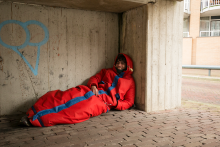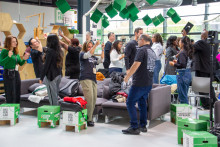To transform it into an ‘Urban Safety Kit’, the Designlab of the UT, the Saxion lectorate Smart Functional Materials and the Sheltersuit Foundation will incorporate electronics and smart textiles into the suit. Edo de Wolf (24), project coordinator at the Designlab tells us about how the project came into being.
Can you tell me something about Sheltersuit?
‘It was founded in 2014 by Bas Timmer, a designer from Enschede. After the father of two of his friends died in the streets because of hypothermia, Bas decided that he wanted to design a solution for this. Since then, over 1800 Sheltersuits have been distributed, not only in the Netherlands but also at the Kara Tepe camp on the Greek island of Lesbos. The suit is made of waste materials, so it is a product of circular design.’
How did the DesignLab come into contact with Sheltersuit?
‘About a year ago Jurrie Barkel, who is treasurer at Sheltersuit, came to the Designlab to tell us about the idea. The suit caught our attention and we hosted a brainstorm session to discuss how we could add technology to the suit. We had some ideas, but there was no immediate follow up. But a few months ago, we found out that WEAR sustain was offering a grant of €50.000 that we could apply for. So we sat down and the idea of the Urban Safety Kit was born.’
What is the Urban Safety Kit?
‘We will turn the Sheltersuit into an Urban Safety Kit by adding technology, focusing on three aspects. The first is medical safety; one of the main problems among homeless is having to face the cold. To detect hypothermia, things like a heart rate and body temperature sensor can be added to the suit, and could then send out an S.O.S. or an alarm. The second aspect is protection from violence; homeless people are often robbed or even set on fire while they are sleeping. So we can think of a proximity alert to avoid this. The third aspect is connectivity. A lot of homeless people actually have smart phones and tablets, but they can not always charge their devices and stay connected to society. So if we can offer something like solar panels or a battery pack to solve this.’
Who does your team consist of?
‘We are working with a number of students from Mechanical Engineering, Electrical Engineering and Industrial Design. We are currently reaching out to professors and researchers that can support us in this project. We also work together with Sheltersuit and the Saxion lectorate Smart Functional Materials to combine our different levels of expertise.’
How is the project going so far?
‘We are still figuring out the needs of the users, the target group is difficult to stay in touch with or to get into contact with. All of the aspects we are focused on are based on experience, so we are still in the process of figuring out what is most important for the homeless. We also want to look at refugees, because they face many similar problems to those of homeless people. Sheltersuit is going to see if they can get feedback from the refugees they handed suits out to and we will hopefully be able to use their network to gain more insight into the requirements. We need to try as many things as possible and use the prototypes we make to test and get feedback.’







